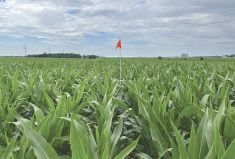Chemical controls have reached a point where “more of the same” may not work, so the search is on for new or alternative methods. If you want to control wireworms, one of those methods might be buckwheat.
It’s an approach discovered by Agriculture and Agri-Food Canada researchers on Prince Edward Island, where Christine Noronha and Jason McCallum have found buckwheat to be an effective biofumigant for wireworm in potato. Their work, along with additional research by AAFC colleagues, determined buckwheat is not only effective against wireworm but it also helps prevent soil diseases and could be a marketable crop.
Although their project is complete, Noronha and McCallum have proposals to continue the research. Noronha believes in the long-term potential of buckwheat as a wireworm suppressant, a quality shared with brown mustard. Both have chemicals that include acyl sucrose, which causes hormonal imbalances and improper growth in wireworms. But Noronha concedes little is known about plant interaction with insect pests and their response to different chemicals created by plants.
Read Also

Could crop sharing be a viable option for your farm?
Crop sharing could be a good option for young and beginning farmers.
“When we did discover that buckwheat has a negative impact on wireworms, it was a big deal to begin with,” says Noronha, a scientist with AAFC Charlottetown. “Then it took a while to determine this chemical and how it works.”
An interesting finding of the research is that the wireworm species particular to potato doesn’t avoid plant roots where the chemical is released — it prefers it, similar to “the moth to the flame” analogy.
“At first, we were wondering if they weren’t going to the roots but we found numbers deceasing and realized the buckwheat had some sort of an effect,” Noronha says. “They actually choose buckwheat, even though it’s not good for them as a food source.”
A sweet find
The insecticidal effect of acyl sucrose was discovered by McCallum, a phytochemist who works with Noronha. He notes such finds are not uncommon, pointing to the synthesis of pyrethroids from the roots of chrysanthemums.
The challenge with acyl sucrose is determining its cost efficiency in creating a synthetic product versus leaving it to nature to produce the key chemical through the crop.
“These chemicals often have ecological or defensive properties, and a lot of the time it’s against insects,” McCallum says. “I became involved in this buckwheat project and it’s a rather unusual crop in that it’s not really closely related to anything else we grow.”
At first he was curious as to what chemicals were present in the plant, so he grew it in the field and in growth chambers. Then he examined the chemical composition of the buckwheat plant during development, all the way from a germinating seed to a plantlet to maturity.
“I looked at the chemical profiles in flowers, leaves, stems and roots,” he says. “Wireworms are pests that are present in the soil, so the main place between the buckwheat roots and the insect is where they’d interact — in that root zone.”
There was anecdotal evidence that if a grower planted buckwheat, it would help control wireworms. But no one knew the mode of action: was it plowing down biomass into the soil and letting it rot with a resulting chemical reaction? Were chemicals being produced and secreted by the roots into the soil? Or was it something that had nothing to do with chemistry and more to do with the plant making the soil drier?
“I went into it with the viewpoint that I was going to look at the chemicals and I’m going to focus on the roots as being the most likely place where the pest and the plant would interact,” McCallum says. “When I went through that process and looked at all of that chemical data, there was a rather unusual family of chemicals being produced in the roots, which are the acyl sucroses. They’re really only in the roots, making that a kind of a smoking gun.”
It’s a chemical production process that McCallum says is unique to buckwheat, both in terms of the molecules and the crops grown, be it cereal crops or horticultural crops. Buckwheat is more closely related to the weed known as curly dock or yellow dock.
“You see an unusual chemical profile like you’ve never seen before, it’s in the right tissue and it all kind of lines up,” he explains. “Plants can’t get up and run away when there’s an insect or a pathogen, and they’re in competition with other plants, making them great at synthesizing chemicals that do really potent things.”
Longer-term prospect
Synthetic chemistry has done a very good job in developing insecticides, yet there are only so many ways of reformulating products or blending existing chemistries before they’re ineffective. Then there’s the cost of developing new products, which is as prohibitive as it is lengthy, along with the cost of regulation. And the general public is becoming increasingly concerned about synthetic chemicals. This makes options such as biocontrols more attractive, but McCallum cautions they are not a cure-all.
“Biological products tend to be more specific in their range,” he says, noting acyl sucrose molecules have distinct effects on the natural development of wireworms. “It isn’t some broad-spectrum neurotoxin that leaves all insects twitching in its wake. Wireworms have to eat it, they have to be exposed to it for long periods of time, and there are limited potential for off-target effects. The whole bio-route for discovering these things is going to be very important going forward.”
The researchers see a longer-term process that adds buckwheat to the rotation as part of an integrated pest management (IPM) approach. That’s made it a bit easier by its marketability: it’s not just a cover crop. Noronha says several growers have made the transition and are growing buckwheat for sale — it’s in demand in Japan and it’s gluten-free. In her first presentations, Noronha suggested plowing down the buckwheat, but with further research she showed it can be grown for seed and still provide wireworm suppression.
“The seed is definitely marketable and it’ll still provide the benefit as it would be with a plow-down, and that’s making it a little more acceptable for growers to grow it,” Noronha says. She acknowledges the challenge of rotating out of potatoes with nothing growing for two years as a big risk. “But if you can give them an alternative where you could actually grow buckwheat for seed and get some money from it, it’s an economically viable option for them.”
Noronha has tested brown mustard, buckwheat and barley in reducing wireworm damage, and although buckwheat ranks second to brown mustard, there are more benefits to buckwheat. It can reduce the impact on wireworm while providing benefits to soil health, adding organic matter and raising phosphorus to the surface, making it more readily available to the next crop.
















